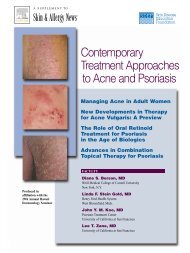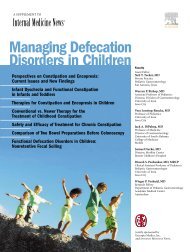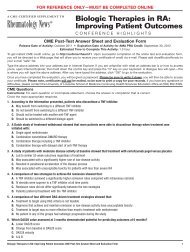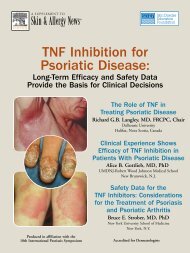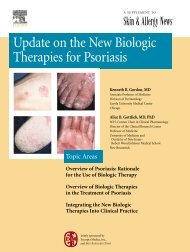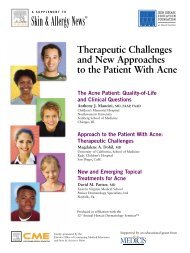Clinical Presentation andPathophysiology of Atopic DermatitisLawrence F. Eichenfield, MDAtopic dermatitis has beenshown to be increasing inprevalence in industrializedcountries since World War II, andthe condition is now estimated toaffect more than 10% of childrensometime during childhood. 1Experienced dermatologists canusually distinguish atopic dermatitisfrom other types of dermatitis.However, the differences may not beso obvious to the nonspecialist. Distinguishingatopic dermatitis fromsimilarly appearing eczematous skinconditions such as contact dermatitishas recently achieved a new level ofurgency and relevance because atopicdermatitis is a contraindication <strong>for</strong>smallpox vaccination.Diagnostic Criteria RevisitedFor more than two decades, theHanifin-Rajka criteria have beenused to define atopic dermatitis. 2Diagnosis using these classic criteriais based on a patient having three ormore basic features and at least threeminor features from a list of morethan a dozen. The basic features are:(1) pruritus, (2) a typical morphologyand distribution—facial andextensor involvement in infants andchildren, flexural lichenification orlinearity in adults, (3) chronic orchronically relapsing dermatitis, and(4) personal or family history ofatopy (asthma, allergic rhinitis, oratopic dermatitis).The American <strong>Academy</strong> ofDermatology (AAD) held a consensusconference on pediatric atopic dermatitisin which Hanifin et alreviewed and updated the classic criteriato help facilitate recognition ofthe disease by nondermatologists.The conference participants came upwith the following simplified diagnosticcriteria <strong>for</strong> atopic dermatitis.Essential FeaturesThese features must be present <strong>for</strong> adiagnosis of atopic dermatitis:• Pruritus• Eczema (acute, subacute, chronic)– Typical morphology and agespecificpatterns (includingfacial, neck, and extensorinvolvement in infants and children;current or prior flexurallesions in any age group; sparingof groin and axillaryregions)– Chronic or relapsing history“Atopic dermatitishas a compleximmunology, whichis one reasonwhy it is so difficultto manage, particularlyin patients withsevere disease.”Important FeaturesThese features are seen in mostcases and add support to the diagnosis:• Early age of onset• Atopy (personal and/or familyhistory)• Serum immunoglobulin E (IgE)reactivity• XerosisTable 1. Western Lifestyle, Urbanization, andIncreasing Prevalence of Atopic DermatitisMost of the other classic secondaryfeatures of the Hanifin-Rajkadiagnosis, such as keratosis pilaris,facial pallor, and ocular changes,were de-emphasized by the AADconsensus conference and termed“associated features” that helpsuggest diagnosis but are too nonspecificto define or detect atopic dermatitis<strong>for</strong> epidemiologic purposes.Understanding the Pathogenesisof Atopic DermatitisAtopic dermatitis has a compleximmunology, which is one reasonwhy it is so difficult to manage, particularlyin patients with severedisease. Unraveling the compleximmunology will enable researchersto better understand why there issuch variability in patient diseaseactivity, why atopic dermatitis hasstrong associations with other atopicconditions, and why the disease isincreasing in prevalence. Increasedunderstanding of the mechanismsinvolved will in turn lead to newtherapeutic interventions.Research on the pathogenesis ofatopic dermatitis has come up withsome interesting immunologic findingsthat characterize most patientswith the disease, including increasedIgE synthesis, excessive T-cell activationin response to an antigen, abnor-• Increasing prevalence over the past 30 years in industrialized Western countries• Prevalence higher in immigrants to Western countries than in native lands• Prevalence higher in industrialized countries with a market economy• Prevalence higher in urban than in rural areas• Prevalence higher in privileged socioeconomic groups and smaller families• Increase most obvious in children and young adults• Increasing prevalence with increasing industrialization in developing countriesSource: Eichenfield LF, et al. Pediatrics. 2003;111:608-616.4 New Strategies in the Management of Inflammatory <strong>Skin</strong> Diseases
mal Langerhans’ cells, and dysregulationof phosphodiesterase. Two ofthese processes—excessive T-cell activationand hyperstimulation of Tcells by atopic Langerhans’ cells—areof particular interest in this discussionbecause blocking this reaction isthe mechanism by which the newtopical calcineurin inhibitors tacrolimusand pimecrolimus work.In atopic dermatitis, the two subtypesof T cells primarily affected areT-helper type 2 (T H 2) cells, whichare associated with the acute phaseof disease, and T-helper type 1 (T H 1)cells, associated with the chronicphase (typified by the itch-scratchcycle and thickening of the skin).The shift from a T H 2 to a T H 1cytokine profile in atopic dermatitisis quite fascinating, as thesecytokines play a prominent role inthe so-called hygiene hypothesis.Atopic Dermatitis andthe Hygiene HypothesisDeveloped from epidemiologicdata, the hygiene hypothesis proposesthat exposure to bacterial andviral infection early in life (e.g., viaovercrowding and unhygienic contact)strengthens the immune systemand thus may offer protection fromatopic diseases. In recent years, itsinterpretation has been refinedsomewhat to embrace the idea thatinfections early in life promote developmentof T H 1 cytokines, whereasfewer infections early in life favor thedevelopment of T H 2 cytokines andatopy.A recent review of epidemiologicdata by Bach 3 and an accompanyingeditorial by Weiss 4 in The NewEngland Journal of Medicineexplored the association between amarked decrease in infectious diseasesand a marked increase in theprevalence of autoimmune andallergic diseases since the 1950s. Ofinterest among Bach’s findings werethat measles may ameliorate theseverity of nephrotic syndrome andatopic dermatitis, and that childrenwho received antibiotics in infancyhave a higher incidence of allergyand other atopic disorders thanchildren who did not. He alsoreviewed the literature on administrationof probiotics as a means ofdecreasing the incidence of atopicdermatitis.Some of the epidemiologic parallelsbetween asthma and atopic dermatitishave been summarized in arecent review by this author and colleagues.5 These parallels include anincrease in prevalence over the past30 years in industrialized Westerncountries, higher prevalence in immigrantsto Western countries than intheir native lands, higher prevalencein urban than in rural areas, higherprevalence in privileged socioeconomicgroups and smaller families,“More than threequarters of childrenwith atopic dermatitismay go on todevelop asthma orallergic rhinitis.”and increased prevalence withincreased industrialization in developingcountries (Table 1). This increaseis more obvious in children and inyoung adults. Beyond the epidemiologicparallels, atopic dermatitis andasthma share immunopathophysiologicsimilarities such as IgE reactivityand T H 1/T H 2 cytokine response, aswell as a genetic contribution(Table 2).In summary, atopic dermatitis isclearly related to asthma. Atopic dermatitisis frequently the first manifestationof an atopic diathesis, whichincludes asthma and allergic rhinitis. 5More than three quarters of childrenwith atopic dermatitis may go on todevelop asthma or allergic rhinitis.Atopic dermatitis presentation usuallypeaks in the first 2 years of life,whereas asthma and gastrointestinalfood allergies usually do not manifestuntil later in childhood. The trend <strong>for</strong>some patients with one allergic conditionto metamorphose into anotherhas been called the atopic march.Table 2. Similarities BetweenAsthma and AtopicDermatitis• Target organ abnormalities:— Immunologic– IgE– T H 1/T H 2 cytokines— Inflammatory— Physiologic• Genetic contributionIgE = immunoglobulin E; T H = T-helper type cell.Source: Eichenfield LF, et al. Pediatrics.2003;111:608-616.Role of Exogenous Allergiesin Atopic DermatitisAlthough the area of externalallergens and how they affect atopicdermatitis is fraught with controversy,it cannot be argued that childrenwith atopic dermatitis have ahigher incidence of allergies to foodand airborne allergens.As many as 80% of childrenwith asthma or atopic dermatitisare sensitized to inhalants such asdust mites, pollens, dander, andmolds. Pediatric dermatologists, inparticular, need to be aware thatapproximately one third of childrenwith moderate to severe atopic dermatitiswill have food allergies(eggs, milk, peanuts, soy, and wheatare the primary culprits in infantsand young children). Food allergiesare more likely in younger and moresevere cases of atopic dermatitis.Interestingly, even though thispopulation has a higher incidence offood and inhalant allergies, thefood or airborne allergen may nottrigger eczematous dermatitis oratopic dermatitis when the patientis rechallenged. Reaction to exposuremay take the <strong>for</strong>m of urticaria,contact urticaria, or gastrointestinalsymptoms. There have been a handfulof documented cases of kwashiorkorin the United States inpatients whose parents have triedto control their child’s atopic dermatitisthrough elimination diets<strong>for</strong> food allergies. Fortunately,the introduction of calcineurininhibitors (also known as topicalimmunomodulators) in the past fewNew Strategies in the Management of Inflammatory <strong>Skin</strong> Diseases 5






